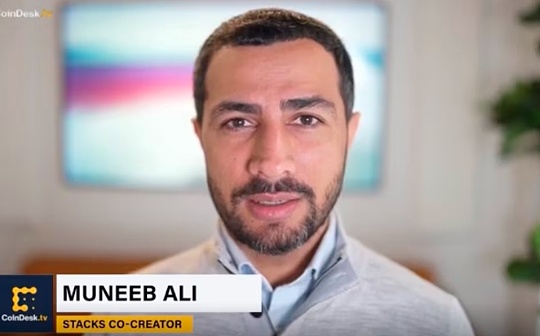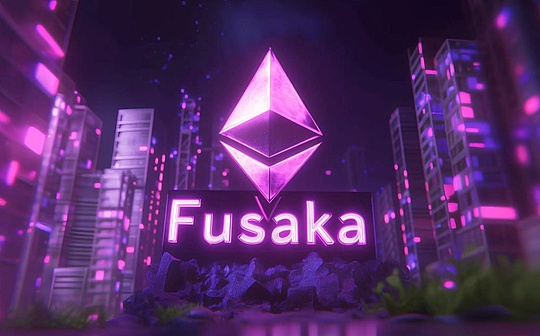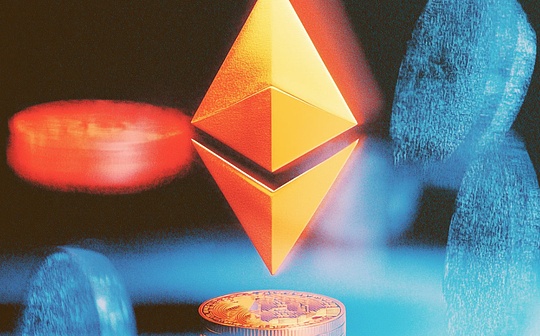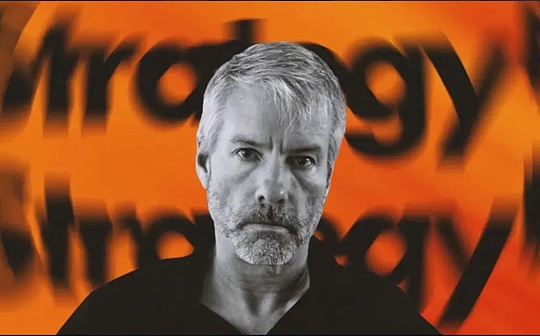
Author: Daniel Kuhn, CoinDesk; Compiled by: Deng Tong, Bitchain Vision
This year may be the most critical year for Bitcoin since its invention, Muneeb Ali, CEO of Trust Machines and co-founder of Stacks blockchain, believes thatLayer 2 is about to usher in a breakthrough.This is not only because Bitcoin (BTC) has hit record highs every week recently — mainly due to the launch of spot BTC exchange-traded funds (ETFs) — but because,More and more people are using Bitcoin – the first cryptocurrency to achieve its intended purpose and use it as a currency.
The introduction of the Ordinals protocol, the rise of BRC-20 tokens based on Bitcoin, and the increasing maturity of network “smart contracts” such as bitcoin, have helped the recovery of Bitcoin’s “fee economy”, that is, payments on Bitcoin exchangesPrice.
in other words,People no longer just buy and hold bitcoin, they use it.
“Yes, the bigger use case is stillBitcoin is a savings technology,” Ali said in an interview with CoinDesk. Ali, an experienced developer who began working on one of Satoshi’s interests, created an on-chain called Bitcoin Name Service (BNS) in 2014Domain name system.
“But if you’re talking about $1.4 trillion of [deployed Bitcoin] capital, if people keep 80% of that in savings, there are still hundreds of billions of dollars of BTC that can be used for productive uses.
Ali predicts that most of the actions will take place on Bitcoin Layer 2 (such as Lightning Network), LayerTwo Labs’ “drivechain” or secondary solutions (such as Stacks), all of which are designed to solve the problem of scaling Bitcoin and making it moreThe same problem with ease of use.He said that it is conceivable that in the future, Bitcoin users will not send on-chain transactions at the bottom every day.
CoinDesk interviewed Ali last week to discuss Stacks’ long-standing Nakamoto upgrade, his appreciation for other apps such as Ethereum and Solana to optimize the network, and “a revival of people’s interest in Bitcoin Layer 2.”
Stacks has been around for a long time and, to its credit, has been innovating continuously.The upcoming Satoshi Nakamoto upgrade has been going on for several years.Honest answer: Did Stacks accumulate technical debt?Or have the decisions you made before limit what you can do today, or have made something more difficult?
From a code perspective, there must be technical debt, right?If you already have a code base and are upgrading it, there will be friction when making changes in real-time and in production.Let me give you an example: Today, $1.4 billion in STX capital has reached a consensus.The first thing that will happen is that people will unlock their capital and lock it into a new consensus protocol—that is, $1.4 billion is unlocked and transferred in one place, rather than just launching a new system.
At the same time, I want to emphasize that this is exactly the type of challenge that Bitcoin Layer 2 should be able to handle.This is why the entire system is durable.L2 moves very fast.Bitcoin won’t change much.L2 is innovative and willing to make quick changes.After a while, it becomes a part of their culture.These days, I see a major upgrade of the “XYZ ecosystem” every six months: it’s very healthy for Bitcoin.
The fragmentation of Layer 2 on Ethereum is a new problem with the network.Do you think Bitcoin needs Layer 3 in the end?
We’ve seen this already.Stacks has something called the Bitcoin subnet-the work is done, but it never really starts completely because people are paying too much attention to Satoshi Nakamoto now.The basic concept is to use Stacks to execute logic and security in the middle between subnets, which can get more permissions while putting all states in the subnet onto Bitcoin Layer 1.This allows you to use BTC liquidity.This is exactly what people call Layer 3, where you can reuse fragments of different L1 and L2 components.
We are developing these SDKs (Software Development Kits) that can help developers use Stacks subsets – let me give you an example.Suppose someone wants to use Bitcoin Layer 1 as the data availability layer, but Stacks has a huge network of signers (currently locked at $1.4 billion), a decentralized signer community and over 30 institutions.Therefore, they can pick signers using L2 to build interesting applications.As things become more modular, this is an interesting area,We will definitely keep an eye on whether Stacks will be the leading L2 and can be reused in quote unquote L3.I think this is something developers really like.
Can this interact with the Lightning Network?
Not many people know this, but Stacks is already connected to the Lightning Network.There is a protocol called LNSwap that uses atomic exchange to exchange Satoshi on the Lightning network for assets on Stacks.You can start extending the feature because the stack is almost like the routing layer of a subnet.Any stack that has been connected to a subnet is connected to, which is a huge benefit.
How do you view the status of the Bitcoin oracle ecosystem?
Some of the direct conversations I have with oracle developers are about how they find it difficult to integrate directly with Bitcoin.This is common: Bitcoin has an eloquent scripting language, but it is really hard to use, and it has limited functionality.Interestingly, Stacks has an oracle service whereby the mining process allows people to get local feedback on the BTC/STX price pairs because the bidding is done on the chain – it is like the on-chain oracle of the STX/BTC price..Some people find this interesting.
What I want to say now is,The oracle on Bitcoin L1 is a bit limited.Most of them work, assuming we have off-chain oracles that control multi-signatures—they are not the most advanced oracles like Ethereum or Solana.On L2, Python [network, a cross-chain oracle solution] has been launched, and other oracles are coming soon, which can fill this gap as much as possible.This will be a big step forward as it connects points and allows more expressive contracts to have full functionality like Solana or Ethereum.It will greatly improve the programmability of Bitcoin.
Is there a risk of invisible risk of adding programmability to a rather limited-designed system?A version of this debate has already been staged on issues like Ordinals.
I think that through BitVM, there is an unexpected discovery that Bitcoin is already Turing-complete.There is a warning: these programs are very inefficient to build.Technically, with BitVM you can build almost any application.But reality is still far from having a complete smart contract.Because BitVM programs are mostly off-chain, they don’t directly affect anything – just proof that the steps happen on Bitcoin L1, which is quite limited.
If Bitcoin changes its script to something like EVM, that would be a huge change, right?It’s like you suddenly open up to all kinds of things.BitVM does have some new features, but it’s very limited.
That is, with Taproot, we see that even with limited additional features, people can build new things.So I absolutely think people will try a lot of new things.What I’m excited about with BitVM is very targeted applications because it’s often an inefficient way to write programs.例如,无需信任的桥梁。Trustless bridges actually don’t have much impact on L1, as all features are on L2.This is a big purpose for BitVM, as L1 is still protected.People may also try to do other things with BitVM.But it’s a very heavy load, all of which are very complex and inefficient.
Is there anything you admire about Ethereum or Solana?
This is actually quite interesting, right?I’m with some other bitcoin people and I’m surprised that they rarely pay attention to what’s going on elsewhere in the industry.I’ll give you a specific example, and I think this might be beneficial.
Everyone wants to support the development of Bitcoin core; they are doing thankless work and there should be better ways to support them.I made the point that these other ecosystems actually have very smart engineers.Algorand, for example, has a PhD from MIT – just like the real smart people who build real blockchains and have experience running production systems.But there is no good way to learn from their experience.
How to hire and retain these people?How do you motivate them?The rest of the blockchain ecosystem is actually quite competitive.When we try to hire core developers for Trust Machines, we compete with Solana Labs and Avalanche.This is a very competitive market, but Bitcoin lacks action.Like, they don’t even play that game.A large number of lessons can be learned from other areas of the industry, which can be integrated into the Bitcoin core, thus making core development more efficient, more capitalized, and better talents.
You might get a version of this question and every interview you do, but all the available evidence suggests people want to hold Bitcoin.70% of the addresses are not moved.Inflows to ETFs indicate that people are investing Bitcoin in long-term savings.Why do you believe that the future of Bitcoin smart contracts will be as full of imagination as Ethereum?
I do hear this question a lot.My thoughts are: I have cold-storage bitcoins and some other cryptocurrency capital that I want to try.This capital can be ETH capital or SOL capital, but it can also be BTC capital.The simple fact is that it is much better to have BTC capital – that’s the difference between them, right?People spend bitcoin.
People forget that Ethereum ICO (initial token offering) is done with BTC.BTC raised $18 million but sold out.Rootstock raised 35,000 BTC.If you look at Ordinals traffic, you will find some new NFTs, such as Quantum Cats launched by Taproot Wizards.它以 BTC 形式售罄。So I feel the data shows that people do deploy their bitcoins.
Yes,The bigger use case is still that Bitcoin is a savings technology.But if you’re talking about $1.4 trillion in capital, if people save 80% of that as savings, there are still hundreds of billions of dollars of BTC available.This is more than any other chain except Ethereum that can be deployed and put into production.
Then there is institutional use.At present, there is no direct, decentralized way to securely earn Bitcoin income.If there is a healthy, decentralized smart contract option, it can transform Bitcoin from a passive, non-yield asset to a productive asset.This will accelerate mechanism adoption.
I mean, institutions may refuse, and for similar reasons, Bitcoin holders may hesitate: You are introducing smart contract risks.
This is risky, right?But every market has a risk-reward ratio.There are different ways to do this, too.Work is currently underway so that people can keep BTC in the DLC of Layer 1 and only when it is liquidated will the BTC be transferred to L2.But if you are liquidated, it is no longer your Bitcoin.Therefore, DLC may be a very safe way to keep Bitcoin while still participating in DeFi.In a way, I think it’s much safer than handing over your bitcoin to a company.
Obviously people value their Bitcoin and don’t want to lose it.But that doesn’t mean that free market solutions should not exist in order to make a profit.If some people want to take more risks with some of their own bitcoins, they should be free to do so, but at the moment these options do not exist.My intuition is that there is actually a lot of demand.
If you do it again, will you still use Reg A+ tokens?
In some ways, we can still benefit from it.It helps people know that the product is transparent and completely legal – it builds credibility into the ecosystem.Another thing it does is that it actually forces [Stacks] decentralization very, very early before the mainnet starts.The initial companies exist in some form, but everyone involved formed independent companies and pursued different goals.This is a practical ecosystem.No Solana Labs can do all the work.On the other hand, it becomes more difficult to coordinate between so many different entities.
There are other challenges.For example, many exchanges, especially those in the United States, do not understand Reg A+’s products and are hesitant to list the token.People are not used to this process.This is a mixed situation, but overall, I need to thank this opportunity.Ultimately, it brings a lot of transparency and credibility to the project.
Especially on Twitter, you will be hated by bitcoin lovers.Under every post, someone will ask you why you launched a token, or call you a liar.How do you personally stay motivated in such a hostile environment?
Honestly, things are getting better.It was the dark age of Bitcoin.What helped me was people I really respected—bitcoin OGs like Erik Voorhees, Jameson Lopp and many others—are very supportive.
Privately, I had a more friendly conversation with everyone.Furthermore, a lot of the criticism comes from those who joined Bitcoin in the Dark Ages, and I just think their information is incomplete.Bitcoin is a free market solution.When you don’t understand Bitcoin, you’ll say “You can do X on the network, but not Y”.
Another thing is that it gets better because new builders are coming and new tools are being built.The community is full of excitement.It is a mentality, or, to some extent, a personality.
I joke that the first quality of a person who actually completes a PhD is stubbornness.If you are stubborn about an idea and you really believe it, you will always take the blow, right?There is a feeling of satisfaction when you cross the finish line.








